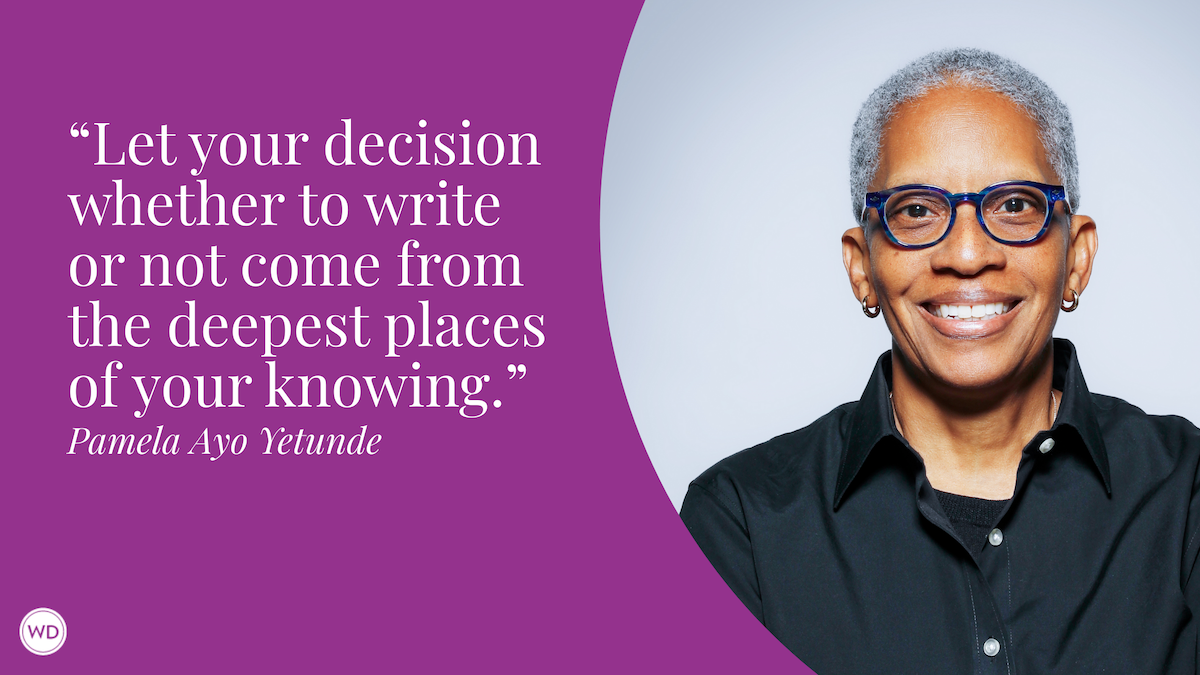Memoir as Detective Novel
Every memoir requires searching for the truth of the story. Lilly Dancyger, author of the memoir Negative Space, shows how this hunt can serve as the structure of the narrative.
This article originally appeared in the September/October 2021 issue of Writer's Digest.
Writing a memoir requires a lot of searching for the truth—questioning what you think you know, digging up the past to ask what really happened, hauling secrets out of the back of the closet, and comparing different people’s recollections in an effort to pin down the real story. Most of the time, this digging and searching happens behind the scenes, off the page. It’s the research that allows the author to then sit down and write the truest possible version of the story.
But some memoirists incorporate this process of digging and searching and questioning into the narrative of the book itself, in a style I like to call the “memoir as a detective novel.”
The Form
In a memoir as detective novel, the search for the heart of the story is the story. The desire to uncover the truth is the driving force of the narrative—the author brings the reader along on their quest, much like we go along for the ride in a detective novel or a crime procedural TV show. Except instead of “who done it,” it’s a search for answers to more diffuse questions like, “Who am I?” “Where do I fit in my family?” or “What is the truth of my past?”
This is the form I used for my memoir, Negative Space. At its core, Negative Space is the story of my father’s life, art, heroin addiction, and death, and the narrative starts 20 years before I was born. Woven in with my father’s story is the story of my adolescence, which was largely defined by my grief over his death when I was 12. But it’s the third narrative strand that provides the backbone for the book and pulls readers through—the story of the 10 years I spent piecing together the truth of my father’s life by reading his notebooks and letters, studying his artwork, and interviewing more than two-dozen people who knew him. It’s the story of this search that holds the other narratives together and provides forward momentum in the book.
When a personal narrative is treated like a mystery, each clue, each revelation, is an opportunity for complexity and emotional depth on the page. Think about a good detective story—it’s not just the final reveal that’s exciting, but each small piece of the puzzle that brings the hero one step closer to figuring it out (or sends her backward into confusion, upending what she thought she knew).
The memoir as detective novel works similarly. Each new piece of information I learned about my father became not only more detail for his story, but more texture and complexity for mine—layering my reactions on top of the story I was reacting to. For example, when I learned that my father had lost his first love to the same drug that would later destroy him, I incorporated that heartbreak into my telling of his story; but I also wrote about wishing that seeing what heroin could do to a person had been enough to scare him away from it, and about how seeing how hurt and angry he was when she chose heroin over him allowed me to claim my own hurt and anger for the first time.
This meta layer of the story of finding the story creates a space for the writer to engage with the reader more directly—to grapple with the big questions that are being raised within the core narrative, and to let the reader into the fraught, emotionally and mentally disorienting process of turning one’s own life into a story fit for mass consumption.
Formative Examples
The Night of the Gun by David Carr is perhaps the ultimate memoir as detective novel. In his memoir, Carr, who was a well-known journalist, puts his investigative skills to work as he tries to piece together the story of his life as an addict. The big twist in the book comes when he interviews a friend and discovers that an experience he considered formative didn’t actually happen the way he remembered it. So rather than figuring out the true version first and putting that down on the page, he uses the conflict between his memory and the version of the story he uncovers as the book’s main tension.
Right at the beginning, Carr tells the story of this fateful night, “the night of the gun,” and describes his friend’s recollection of it, which is drastically different from his. Then he sets the narrative in motion with the question, “If I was wrong about the gun, what else was I wrong about?”
The rest of the book is his attempt to answer that question—to reconcile the version of his story he remembers and the one others describe to him. Or, as he says a few pages later, “In the novelized version of my life, I was basically a good guy who took a couple of wrong turns and ended up in a ditch. In the reported version, I was a person who saw the sign that said dangerous curves ahead and floored it, heedlessly mowing down all sorts of people at every turn.”
“For two years on and off,” he writes, “I would call a long-lost person, set up a time, and then come in with a bunch of questions, the video camera, and a voice recorder. I would engage in small talk and then point to some huge scab from the past. ‘Do you mind tearing that off?’” He goes on to describe more about the interview process, and then ends this setup chapter with the line “This is what they told me,” which launches us into the rest of the book with a clear understanding that we’re going to go along with him on this journey.
Another book that uses this form is All You Can Ever Know by Nicole Chung—she draws us through the book with the narrative of her search to learn as much as she can about her birth family as she reconciles the conflicting feelings she has about being a transracial adoptee.
Chung sets up the idea of two conflicting versions of a story right at the beginning, much like Carr does. She opens the book with the simple version of the story of her adoption, the one her parents told her when she was growing up. “This was the foundation on which they built our family,” she writes. “As I grew, I too staked my identity on it. The story, a lifeline cast when I was too young for deeper questions, continued to bring me comfort. Years later, grown up and expecting a child of my own, I would search for my birth family still wanting to believe it.”
That setup launches us into the rest of the book with the understanding that there’s one version of the story she wants to believe, and another, more complicated version, that she will uncover. And it’s that tension that keeps us turning the page.
In All You Can Ever Know, Chung connects her own questions about her family of origin with the broader questions all adoptees grapple with—why they were given up, where they belong, what connection they have to their birth family, and in some cases, to the culture into which they were born but not raised. So even though she’s digging into her very personal family history, the questions she’s asking are much more universal.
And in The Night of the Gun, it’s not just that Carr wants to know what happened when he was blacked out, out of some morbid curiosity—it’s that he needs to face the depths he reached as an addict in order to reconcile his past with his present, in order to make peace with the things he’d done and stop running from them. He can’t build a new life on the foundation of delusion, so he needs to know the truth. Once those stakes are set, it’s not a self-indulgent inventory of his wrongs—it becomes a much more universal story about the honesty necessary for recovery. This connection to larger questions that the reader can see their own story in is essential to a successful memoir as detective novel.
Raising the Stakes
I read The Night of the Gun early in the process of writing Negative Space, and the idea that the search for the story could be part of the story was a revelation that made my book’s structure start to fall into place. In my early drafts, I was just telling the story of my father’s life, refracted through the symbolism in his art. I wanted to learn more about my father because he was dead and I missed him, but I knew that wasn’t going to be enough for readers. I knew the project was missing “stakes” in the way the publishing industry understands them. But if I treated my father’s story like a mystery, bringing readers along as I tried to get at the truth, suddenly there was an urgency that hadn’t been there before. Suddenly, I could imagine people who had never known my father eagerly turning page after page, invested in what was going to happen next.
Read Negative Space by Lilly Dancyger
[WD uses affiliate links.]
I ended up using a setup similar to Carr’s, opening the book with an overview of the puzzle I spend the rest of the story trying to piece together. I explain, “If I just went ahead and enjoyed college and started planning for a career and becoming my own full person in the world, leaving the heaviness of grief behind, I feared then my father would be truly gone—somehow even more than he already was. The only way to stop that from happening, I thought, was to find a new way to grieve for him. I wanted my relationship with my father to change and grow, like every parent-child relationship changes when the child becomes an adult—even if that just meant my relationship with his absence.”
In the next chapter, I realize that because my father was an artist, I have a tangible record of his life to engage with in his artwork, setting the story in motion with, “If I could figure out what was going on in his life when he made each piece, maybe I could read his sculptures like a story. Maybe I could almost hear my father’s voice.” So, like Carr and Chung, I tell the reader right at the beginning that I’m trying to understand something, that I’ll be sifting through clues to piece together a truer and more complicated story than the version I start with—and that they’re going to come along for the ride.
It was only after I started thinking of the book I was writing as a mystery that I realized what I was really trying to do: I was trying to find a way to see my father as a flawed, complicated human being—more multidimensional than the idealized perception I had of him as a child. I was going through a version of something everyone goes through at some point; we all have to eventually grapple with our parents’ humanity, whether they’re dead or alive. This, I realized, was the universal thread in my story.
That question—what a memoir is “really about,” what universal themes readers will be able to see themselves in—plagues many memoirists. We don’t often know the bigger themes and questions of a story when we start writing it; we just know we have a story to tell. But for writers who find themselves at an impasse when it’s time to define the emotional stakes, the larger “so what” of their story, the memoir-as-detective-novel form might help them get there in an authentic way. This form has an inherent urgency because everyone loves a mystery, but it can also make the internal stakes—the writer’s real motivation for telling this story—clearer, by pushing them to articulate what they’re searching for and what they’re trying to understand. And once that’s clear to the writer, it will infuse the whole story and be more apparent to readers as well.
Lilly Dancyger is the author of First Love: Essays on Friendship (The Dial Press, 2024) and Negative Space (SFWP, 2021). She lives in New York City and is a 2023 NYSCA/NYFA Artist Fellow in nonfiction from The New York Foundation for the Arts. Her writing has been published by Guernica, Literary Hub, The Rumpus, Longreads, Off Assignment, The Washington Post, Playboy, Rolling Stone, and more. Find more about her work and her writing workshops, including a workshop about Writing Other People in Memoir at www.LillyDancyger.com.








